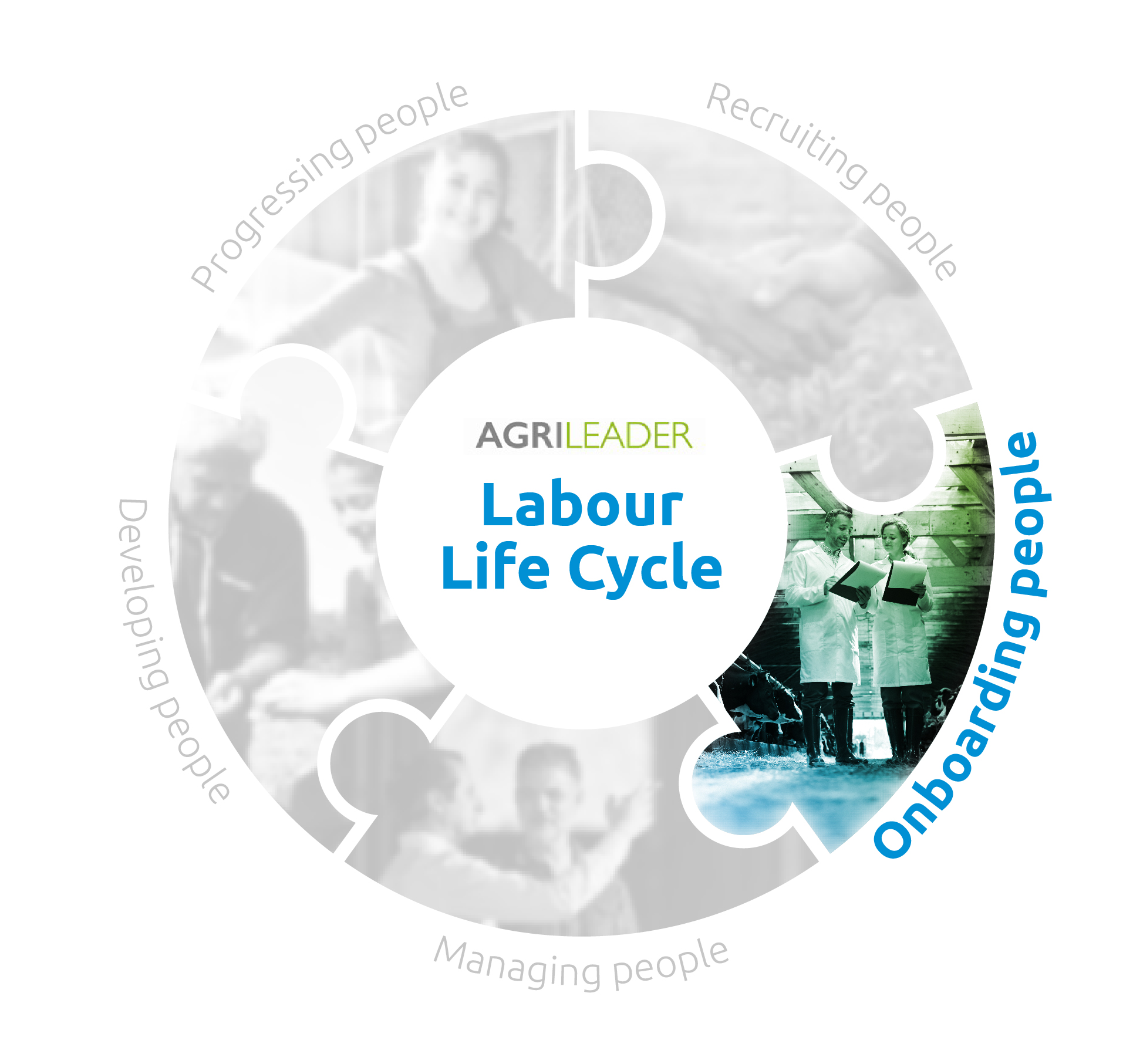- Home
- Onboarding people
Onboarding people
The onboarding process is your new employee's introduction to your farm and business processes, so it’s important to get it right.
Back to: Labour life cycle in agriculture
Here you can find out how to create (or update) your staff handbook for the whole farm team to use. You can also see some useful pointers on how to approach new employee inductions, including any Standard Operating Procedures (SOPs – sometimes called Protocols) and how to manage a successful staff appraisal and the probation process.
AHDB cannot offer advice on preparing farm staff contracts, but you can find out more about employment contracts on the ACAS website
Creating a staff handbook
A staff handbook is not a legal requirement in the UK, but it can add real value to a business. It communicates to everyone:
- The type of business you run
- What you expect from the people who work on your farm
- How the business will deal with any issues and resolve problems
Having a staff handbook also demonstrates your commitment to people and emphasises the importance you place on employee relations. This can help you stand out from the crowd and be seen as an employer of choice.
Your handbook might include your values as a team, your sickness, absence or equal opportunities policies, health and safety guidance, and more.

Top tips
Keep it concise: If the handbook is too long, managers and staff won't want to use it and may see it as a hindrance rather than a help.
Keep it up to date: Give someone responsibility for updating the handbook, as having an out-of-date one is worse than having none at all.
The building blocks of a staff handbook
Your staff handbook needs to be tailored to the needs of your farm. Here are some examples of what you could include, with links to further information:
The business and values: Background and culture, working benefits, ways of working and behaviours.
Social media: Guidelines and rules of engagement.
Health and safety policy:
Maternity, paternity, adoption and parental leave
Diversity and equal opportunities
Performance management: induction, probation, appraisal, performance review and reward
Induction
A good employee induction will include:
- A broad introduction to the place of work and its people
- Essential health and safety training
- Initial stages of any on-the-job training
- Any other information your new worker needs to start their job
STEP 1: Before the employee starts
- Send them any useful information about the farm
- Outline what they will be doing on their first day
- Confirm where they need to go on their first day and who will meet them
STEP 2: First day
- Show them around and introduce them to their team and other colleagues
- Help them understand the importance of their job, who they depend on and who depends on them
- Cover health and safety and share the staff handbook with them
- Schedule some time at the end of the day to check how it went, explain the rest of the week and encourage them to ask questions on anything they might be uncertain about
STEP 3: First week
- Agree on a plan for their first week, who will work with them and how this will be reviewed to ensure they are getting what they need
- Show them any important documents or processes that relate to their job but avoid overwhelming them with too much detail
- Explain when and how formal and informal feedback will work in the first few weeks and months, as well as the probation process
- Explain how their job works and give them an opportunity to try some tasks and ask questions. Shadowing another member of staff is worth considering
STEP 4: First month
- Based on observations and feedback from week one, agree on clear expectations and performance measures
- Identify additional support or coaching to help them learn about the job, the farm’s ways of working and its people
- Provide regular opportunities for giving and seeking feedback to help build both confidence and skills
STEP 5: Three months
- Review performance regularly, identifying any examples of what is working well and what needs improving
- Record progress to ensure this information can be used to make an informed decision at the end of the probationary period
- Agree on clear goals and timescales for any areas of improvement
- Set a probation review meeting at the end of the period to review progress
STEP 6: Six months
- Based on information captured during performance reviews, decide if the employee is to be kept on, fairly dismissed or offered extended probation where the contract permits
- If the employee is kept on, agree on performance expectations and goals and move them into the ongoing appraisal and review process
- Capture feedback on how effective the induction process has been to ensure it adds value and prevents problems in future
The do's and don’ts of staff induction
| Do | Don't |
|---|---|
| Have a PLAN, as this means you and the new starter have the same picture of what you expect them to DO/learn. | Assume people will immediately understand what to DO or pick up jobs as quickly as you. Work at their pace, not yours. |
| Create a written PLAN or checklist. This will make it easier to remember when you MONITOR and REVIEW their progress. | Give everyone the same induction PLAN. Tailor it to the needs of the individual. For example, some people might need induction into a new job but don’t need inducting into the farm. |
| The clearer your PLAN is, the more chance your new employee will spend their time DOING the right things. | Leave them to just ‘get on with it’ and assume that if you don’t hear anything from them, they are ok. Some new employees may not feel confident admitting they don’t understand what to DO or are struggling. |
| Appreciate that induction will be more than just a new employee’s first day. It depends on how much there is for a new employee to learn. | Overload people with too much information too quickly. Break what you want them to learn or DO into manageable chunks and give people time to digest the information. |
| Involve other team members in the induction PLAN so that new employees get to know their colleagues. This allows you to develop skills within the team through coaching and mentoring. | Talk through or explain every piece of information with a new employee. Give them information, plans, and protocols to look at and read, then REVIEW what has made sense to them and what more they need to know. |
| Agree on how you will measure their success, so they know what you will be looking for when you MONITOR their progress. | Throw them in at the deep end because you are busy and need them to just get on with the job. If you do need to get them involved quickly as you have a crisis, REVIEW how they got on and what they have learnt from that experience. |
| REVIEW progress regularly, as this will show your new employee you are interested in them, build their confidence and nip any potential problems or confusion in the bud. | Start an induction and then just let it tail off without following up with REVIEWS. This could give new employees the impression that they aren’t important, and problems or mistakes could snowball and take more time to sort out. |
| Give balanced feedback when you REVIEW progress. Talk about what they are doing well, as well as what you want them to improve or change. If feedback only focuses on problems or mistakes, people get disheartened. They tend not to listen as carefully, and so they miss the opportunity to learn from the experience. | Stick with the same PLAN if you are getting feedback that the new employee is learning more quickly than expected. Adjust the PLAN; otherwise, they will get bored. Alternatively, if the feedback is telling you someone is struggling, then the original plan may need adjusting. |
Probation and appraisal
Remember to schedule regular reviews during the probationary period so you can monitor progress and share feedback between employer and employee. These reviews will help you decide if the new starter is going to stay with the business at the end of the trial period. If so, the reviews will then form part of their ongoing appraisal process as your employee.

The probation review meeting, by Bright HR
Standard Operating Procedures (SOPs)
A Standard Operating Procedure (sometimes referred to as a Protocol) is a set of instructions that helps everyone on site to follow the same process to create a consistent, high-quality product. If you already have SOPs in place, make them part of your induction process. If you don’t already have any, recruiting a new staff member could be the perfect opportunity. Here are some resources to help you create your own.
DairyNZ has kindly given permission for AHDB to adapt their ‘People’ resources for use by the British dairy industry. We share a commitment to supporting dairy industry and will collaborate to provide benefit to New Zealand’s and British dairy farmers.





